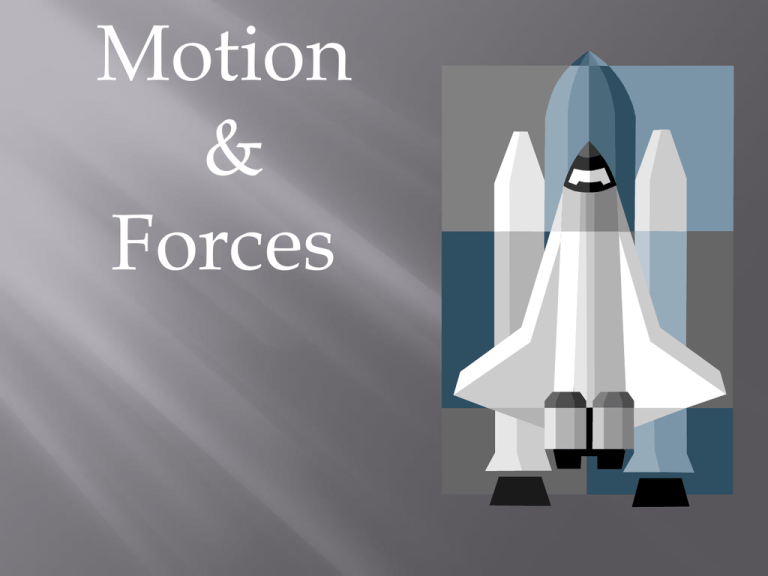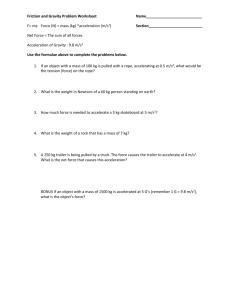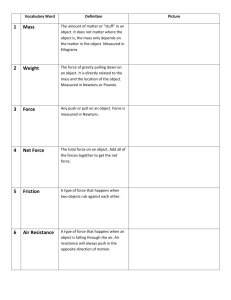Force Force
advertisement

Motion & Forces 1. 2. Force (F)- push or pull (cause of acceleration, or change in object’s velocity) A. Examples: pushing a box across the floor, hitting a baseball, throwing a basketball, etc. Forces influence motion 1. Changes the velocity- speeds up, slow down or changes the direction 2. Forces do not cause motion; they cause acceleration 3. 4. Net force = the combination of all forces acting on an object. Objects accelerate in direction of the net force (if it is zero, then there is no acceleration) 1. 2. 3. Balanced forces – Net Force = 0 (They cancel each other out)= no acceleration but could be at constant velocity. Unbalanced forces – Net force ≠ 0 (they do not cancel) =objects will accelerate Forces in same direction add, opposite directions subtract 1. Measured in Newtons (N)- amount of force it takes to cause1kg of mass to accelerate at 1m/s2. (1 N= 1 kg•m/s2). 2. Representing Force-use an arrow The arrow points in the direction of the force. The length of the arrow represents the strength of the force. Examples: Give direction and which is strongest: A B C 1. 2. Arrows pointing in same direction add together. Arrows pointing in opposite directions subtract from each other. Example: 3N 3N 1N 1N = 4N to right = 2N to right Look at the Force diagrams below: Figure up the net Force and in which direction the object will accelerate. DO NOT COPY - CHECKING YOUR UNDERSTANDING If the forces acting upon an object are balanced, then the object a. must not be moving. b. must be moving with a constant velocity. c. must not be accelerating. d. none of these The answer could be A and it could be B . An object having balanced forces definitely cannot be accelerating. This means that it could be at rest and staying at rest (one option) or could be in motion at constant velocity (a second option). Either way, it definitely is not accelerating 1. 2. 3. Friction- force that acts in a direction opposite the moving object Causes the object to slow down and eventually stop To move an object, your force must be larger than the force of friction 1. 2. 3. 4. Static Friction- force that surface acts on an object to keep it from moving. Ex: box sitting on ground Sliding friction- force that opposes the direction of motion of an object as it slides over a surface: Ex: slide Rolling friction- force that opposes motion of a rolling object. Ex: tires Fluid friction- friction opposing object moving through a fluid such as gas or water. Ex: airplane, submarine 1. 2. 3. Gravity – attraction between two objects due to their mass All falling objects accelerate at the same rate (9.8 m/s2) It depends on the mass of the two objects as well as the distance between them Gravity depends on: 4. 5. 6. the mass of the two objects the distance between the objects Greater mass = greater the attraction of gravity Greater distance b/t objects = gravity decreases 1. 2. Free fall – motion of an object when gravity is the only force acting on it(no air resistance) All objects near earth accelerate at 9.8 m/s2 in the absence of air resistance The 1000-kg baby elephant obviously has more mass (or inertia). This increased mass has an inverse affect upon the elephant's acceleration. And thus, the direct affect of greater force on the 1000-kg elephant is offset by the inverse affect of the greater mass of the 1000kg elephant; and so each object accelerates at the same rate - approximately 10 m/s/s. The ratio of force to mass (Fnet/m) is the same for the elephant and the mouse under situations involving free fall What would happen if air resistance was present. Weight – measure of the force of gravity on an object ‘s mass (changes as gravity changes) Weight = mass x gravity(9.8 m/s2) w = mg Unit: Newton g = 9.8 m/s2 near earth 1 N = 0.225 lb; 1 lb = 4.448 N Mass = does not change EVER Weight = changes as gravity changes= Will change when you go to another planet. 1. A 10 kg mass would weigh ____ 1. A 50 kg mass would weigh ____ 490 N 1. A 100 kg mass would weigh ___ 980 N 1. An astronaut that weighs 600 N on Earth is standing on an asteroid with a gravitational force one hundredth that of Earth. What is his weight on the asteroid? 98 Newtons 6 Newtons Air resistance is the friction caused by air. Terminal Velocity – when air resistance balances weight and the object stops accelerating and reaches its maximum constant velocity 320 km/h (200 mi/h) Fair no net force no acceleration constant velocity Fgrav DO NOT COPY CHECKING YOUR UNDERSTANDING Which of the following statements are true of the quantity mass? List all that apply. a) The mass of an object is dependent upon the value of the acceleration of gravity. b) The standard metric unit of mass is the kilogram. c) Mass depends on how much stuff is present in an object. d) The mass of an object is variable and dependent upon its location. e) An object would have more mass on Mount Everest than the same object in the middle of Lake Michigan. f) People in Weight Watcher's are really concerned about their mass (they're mass watchers). g) The mass of an object can be measured in pounds. h) If all other variables are equal, then an object with a greater mass would have a more difficult time accelerating. i) The mass of an object is mathematically related to the weight of the object. ANSWER: B, C, F, H, I Newton’s First Law- states an object in rest will remain at rest, or an object in motion will remain in motion unless a force(unbalanced force) acts upon it. Also known as the Law of Inertia What will happen when the car hits the wall? 1. 2. While riding a skateboard you fly forward off the board when hitting a curb or rock or other object which abruptly halts the motion of the skateboard. Headrests are placed in cars to prevent whiplash injuries during rear-end collisions Do Not Copy Other Real life examples: 1. Blood rushes from your head to your feet while quickly stopping when riding on a descending elevator. 2. The head of a hammer can be tightened onto the wooden handle by banging the bottom of the handle against a hard surface. 3. A brick is painlessly broken over the hand of a physics teacher by slamming it with a hammer. (CAUTION: do not attempt this at home!) 4. To dislodge ketchup from the bottom of a ketchup bottle, it is often turned upside down and thrusted downward at high speeds and then abruptly halted. 5. Headrests are placed in cars to prevent whiplash injuries during rearend collisions. 1. 2. Inertia - the tendency of an object to resist a change in its motion Inertia depends Only on the mass of an object More mass = more inertia Examples: In car crashes, you tend to remain in motion until you are acted on by a force (until you hit something that resists you) Seatbelts DO NOT COPYCHECKING YOUR UNDERSTANDING 1. A 2-kg object is moving horizontally with a speed of 4 m/s. How much net force is required to keep the object moving at this speed and in this direction? Answer: 0 N An object in motion will maintain its state of motion. The presence of an unbalanced force changes the velocity of the object. 2. Mac and Tosh are arguing in the cafeteria. Mac says that if he flings the Jell-O with a greater speed it will have a greater inertia. Tosh argues that inertia does not depend upon speed, but rather upon mass. Who do you agree with? Explain why. Tosh is correct. Inertia is that quantity which depends solely upon mass. The more mass, the more inertia. 3. Supposing you were in space in a weightless environment, would it require a force to set an object in motion? Absolutely yes! Even in space objects have mass. And if they have mass, they have inertia. That is, an object in space resists changes in its state of motion. A force must be applied to set a stationary object in motion. Newton's laws rule - everywhere! 1. The unbalanced force acting on an object equals the object’s mass times its acceleration F m a F = ma F m a a=acceleration (m/s2) m-mass (kg) F= force (N) newtons 1N = 1kg x m/s2 1. Determine the accelerations which result when a 12-N net force is applied to a 3-kg object and then to a 6-kg object A 3-kg object experiences an acceleration of 4 m/s/s. A 6-kg object experiences an acceleration of 2 m/s/s. 2. An automobile with a mass of 1000 kilograms accelerates when the traffic light turns green. If the net force on the car is 4000 newtons, what is the car’s acceleration? 4000N/1000kg=4m/s2 1. 2. For every action force, there is an equal and opposite reaction force. Forces occur in pairs 4. The action force and the reaction force occur to different objects so the force is not balanced. (movement occurs) DO NOT COPY 1. 2. You push on wall & wall pushes on you Swimming = you push on water and water pushes on you 3. The hammer exerts a force on the nail to the right. The nail exerts an equal but opposite force on the hammer to the left. 4. The rocket exerts a downward force on the exhaust gases. 5. The gases exert an equal but opposite upward force on the rocket. Quick Video If you dropped a 1.5 kg book and a 15 kg rock from the same height, which would hit the ground first? ANSWER: They would hit at about the same time The extra mass of the heavy object exactly compensates for the additional gravitational force. A heavier object experiences a greater gravitational force than a lighter object But – A heavier object is also harder to accelerate because it has more mass (greater inertia) Must be connected to the internet to Play Video





